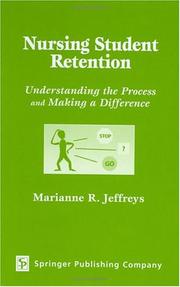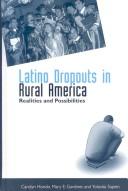| Listing 1 - 10 of 19 | << page >> |
Sort by
|
Book
ISBN: 0674063163 9780674063167 9780674062207 0674062205 9780674066564 0674066561 0674062205 9780674062207 0674266897 9780674266896 Year: 2011 Publisher: Cambridge, Mass. : Harvard University Press,
Abstract | Keywords | Export | Availability | Bookmark
 Loading...
Loading...Choose an application
- Reference Manager
- EndNote
- RefWorks (Direct export to RefWorks)
The vast majority of kids in the developed world finish high school-but not in the United States. More than a million kids drop out every year, around 7,000 a day, and the numbers are rising. Dropping Out offers a comprehensive overview by one of the country's leading experts, and provides answers to fundamental questions: Who drops out, and why? What happens to them when they do? How can we prevent at-risk kids from short-circuiting their futures?Students start disengaging long before they get to high school, and the consequences are severe-not just for individuals but for the larger society and economy. Dropouts never catch up with high school graduates on any measure. They are less likely to find work at all, and more likely to live in poverty, commit crimes, and suffer health problems. Even life expectancy for dropouts is shorter by seven years than for those who earn a diploma.Rumberger advocates targeting the most vulnerable students as far back as the early elementary grades. And he levels sharp criticism at the conventional definition of success as readiness for college. He argues that high schools must offer all students what they need to succeed in the workplace and independent adult life. A more flexible and practical definition of achievement-one in which a high school education does not simply qualify you for more school-can make school make sense to young people. And maybe keep them there.
High school dropouts --- Secondary school dropouts --- Dropouts --- High school students --- Prevention.
Book
ISBN: 1475826761 Year: 2016 Publisher: Lanham : Rowman & Littlefield,
Abstract | Keywords | Export | Availability | Bookmark
 Loading...
Loading...Choose an application
- Reference Manager
- EndNote
- RefWorks (Direct export to RefWorks)
This book by practitioners, policy analysts, and young people, for practitioners, policy makers, and researchers, captures up-to-the-moment experience and as yet unresolved issues in a newly emerging field: dropout reengagement. Key elements in this field include reaching out to young people who have left school for a myriad of reasons, and providing individualized supports and services all the way through to successful re-enrollment. The development of coordinated citywide efforts to re-engage out-of-school youth on positive educational pathways -- in several dozen cities in recent years -- s.
High school dropouts --- High school enrollment --- School attendance --- United States.
Book
ISBN: 1593326343 9781593326340 9781593325206 9781593326340 1593325207 Year: 2013 Publisher: El Paso : LFB Scholarly Pub.,
Abstract | Keywords | Export | Availability | Bookmark
 Loading...
Loading...Choose an application
- Reference Manager
- EndNote
- RefWorks (Direct export to RefWorks)
Liu establishes that high school graduation operates as a turning point in late adolescence in redirecting individuals' adult offending trajectories. High school graduation is individually experienced and especially beneficial to those at high risk of dropping out. It also redirects adult offending trajectories by opening opportunities for experiencing adulthood turning point such as employment and romantic relationships. Liu's work provides empirical support for life course criminology and expands our knowledge about turning points by emphasizing that these events may occur at different stage
Education and crime --- High school dropouts --- Criminals --- Secondary school dropouts --- Dropouts --- High school students --- Crime and education --- Crime --- Social conditions.
Book

ISBN: 0309211026 1283044609 9786613044600 0309163080 Year: 2011 Publisher: Washington, D.C. : National Academies Press,
Abstract | Keywords | Export | Availability | Bookmark
 Loading...
Loading...Choose an application
- Reference Manager
- EndNote
- RefWorks (Direct export to RefWorks)
High school graduation and dropout rates have long been used as indicators of educational system productivity and effectiveness and of social and economic well being. While determining these rates may seem like a straightforward task, their calculation is in fact quite complicated. How does one count a student who leaves a regular high school but later completes a GED? How does one count a student who spends most of his/her high school years at one school and then transfers to another? If the student graduates, which school should receive credit? If the student drops out, which school should take responsibility? This book addresses these issues and to examine (1) the strengths, limitations, accuracy, and utility of the available dropout and completion measures; (2) the state of the art with respect to longitudinal data systems; and (3) ways that dropout and completion rates can be used to improve policy and practice.--Publisher's description.
High school graduates --- High school dropouts --- Dropout behavior, Prediction of. --- Educational indicators
Book
ISBN: 1282392824 9786612392825 1607523388 9781607523383 9781282392823 9781607521327 1607521326 9781607521334 1607521334 Year: 2009 Publisher: Charlotte, NC : IAP - Information Age Pub.,
Abstract | Keywords | Export | Availability | Bookmark
 Loading...
Loading...Choose an application
- Reference Manager
- EndNote
- RefWorks (Direct export to RefWorks)
Plaintext description.
Mexican American students --- Education, Urban --- High school dropouts --- Students, Mexican American --- Students --- Secondary school dropouts --- Dropouts --- High school students --- Inner city education --- Urban education --- Cities and towns --- Urban policy
Book
ISBN: 1593325096 9781593325091 159332491X 9781593324919 9781593324919 Year: 2012 Publisher: El Paso : LFB Scholarly Pub. LLC,
Abstract | Keywords | Export | Availability | Bookmark
 Loading...
Loading...Choose an application
- Reference Manager
- EndNote
- RefWorks (Direct export to RefWorks)
Gasper examines whether drug use and delinquency contribute to early school leaving and whether the effects differ for poor and middle-class youth. Results suggest that drug use and delinquency add little to explanations of dropout. Rather, drug use, delinquency, and dropout are driven by a process of precocious development rooted in early school failure. Driven by a fundamental dissatisfaction with school, precocious teens are more likely to use drugs, take on a job outside of school, and leave school without a diploma in an effort to gain independence. Dropout prevention should start in midd
High school dropouts --- Problem youth --- Juvenile delinquency --- At-risk youth (Social sciences) --- Maladjusted youth --- Troubled youth --- Youth at risk (Social sciences) --- Youth --- Secondary school dropouts --- Dropouts --- High school students --- Social conditions --- Drug use --- Youth with behavior disorders --- At-risk youth

ISBN: 1281813338 9786611813338 0826134467 9780826134462 9781281813336 6611813330 0826134459 9780826134455 Year: 2004 Publisher: New York, NY : Springer Pub.,
Abstract | Keywords | Export | Availability | Bookmark
 Loading...
Loading...Choose an application
- Reference Manager
- EndNote
- RefWorks (Direct export to RefWorks)
In the current nursing shortage, student retention is a priority concern for nurse educators, health care institutions, and the patients they serve. This book presents an organizing framework for understanding student retention, identifying at-risk students, and developing both diagnostic-prescriptive strategies to facilitate success and innovations in teaching and educational research. The author's conceptual model for student retention, ""Nursing Undergraduate Retention and Success,"" is interwoven throughout, along with essential information for developing, implementing, and evaluating rete
Nursing school dropouts --- Nursing students --- Nursing --- Student nurses --- Health occupations students --- Nurses --- Dropouts --- Prevention. --- Psychology. --- Study and teaching
Book
ISBN: 9780826109507 9786613593276 0826109500 0826109497 9780826109491 9780826109491 1280498048 9781280498046 6613593273 Year: 2012 Publisher: New York, N.Y. : Springer Pub.,
Abstract | Keywords | Export | Availability | Bookmark
 Loading...
Loading...Choose an application
- Reference Manager
- EndNote
- RefWorks (Direct export to RefWorks)
This is the only book to offer an evidence-based model for retaining students and ensuring success across the nursing education spectrum. It is designed to assist faculty in creating, implementing, and evaluating student retention and academic success strategies. This model, Nursing Undergraduate Retention and Success (NURS), can be used effectively with all kinds of nursing programs, both traditional and nontraditional, including diploma, ADN, RN-BS, and accelerated BS. The book features the Nursing Student Retention Toolkit , an easy-to-use digital toolkit for assessment and planning that is
Nursing --- Nursing students --- Nursing school dropouts --- Dropouts --- Student nurses --- Health occupations students --- Nurses --- Study and teaching --- Psychology. --- Prevention.
Book
ISBN: 0773411720 9780773411722 9780773426610 0773426612 Year: 2012 Publisher: Lewiston : The Edwin Mellen Press,
Abstract | Keywords | Export | Availability | Bookmark
 Loading...
Loading...Choose an application
- Reference Manager
- EndNote
- RefWorks (Direct export to RefWorks)
Smale and Gounko study twelve men who dropped out of school early, and wound up in juvenile delinquency. While many studies have suggested a link between early school leaving and delinquency nobody has done a study from the perspective of the criminals using dissimilar populations. The directional causality between criminal behavior and dropping out of school has yet to be established, and this study brings researchers one step closer to fully understanding which one happens first. The authors outline a long list of factors that contribute to early school leaving, and they insist that educator
Criminals -- Canada -- Case studies. --- Education and crime -- Case studies. --- High school dropouts -- Canada -- Social conditions -- Case studies. --- Juvenile delinquency -- Canada -- Case studies. --- Education and crime --- High school dropouts --- Juvenile delinquency --- Criminals --- Social Welfare & Social Work --- Social Sciences --- Criminology, Penology & Juvenile Delinquency --- Crime and education --- Crime --- Crime and criminals --- Delinquents --- Offenders --- Persons --- Criminal justice, Administration of --- Criminology --- Delinquency, Juvenile --- Juvenile crime --- Conduct disorders in children --- Juvenile corrections --- Reformatories --- Secondary school dropouts --- Dropouts --- High school students --- Social conditions

ISBN: 1435658752 9781435658752 0791478688 0791473872 Year: 2008 Publisher: Albany, New York : State University of New York Press,
Abstract | Keywords | Export | Availability | Bookmark
 Loading...
Loading...Choose an application
- Reference Manager
- EndNote
- RefWorks (Direct export to RefWorks)
This book affords Latino high school dropouts from rural communities in Idaho the opportunity to tell their stories in their own words. It candidly reveals students' school experiences, explores why students leave school, and looks at the impact of the No Child Left Behind Act (2001). Four of the nine students interviewed for the book passed NCLB-mandated state graduation tests, two others passed two of three sections, and all were capable of achieving success in school. The decision to leave school was connected with students' seeking personal satisfaction and to reduce the social-psychological pain of schooling. In certain cases principals and teachers blamed the Latino students for disadvantaging the school. Latino Dropouts in Rural America presents a systematic approach for addressing the main problem: a lack of cultural responsiveness in school curriculum, instruction, policies, and practices. The leadership plan recommended by the authors will help educators to understand the lives of rural Latino youth and to critique their own schools.
High school dropouts --- Hispanic Americans --- Rural children --- Education --- Social Sciences --- Education, Special Topics --- Children --- Hispanics (United States) --- Latino Americans --- Latinos (United States) --- Latinxs --- Spanish Americans in the United States --- Spanish-speaking people (United States) --- Spanish-surnamed people (United States) --- Ethnology --- Latin Americans --- Spanish Americans (Latin America) --- Secondary school dropouts --- Dropouts --- High school students --- Education (Secondary)
| Listing 1 - 10 of 19 | << page >> |
Sort by
|

 Search
Search Feedback
Feedback About UniCat
About UniCat  Help
Help News
News